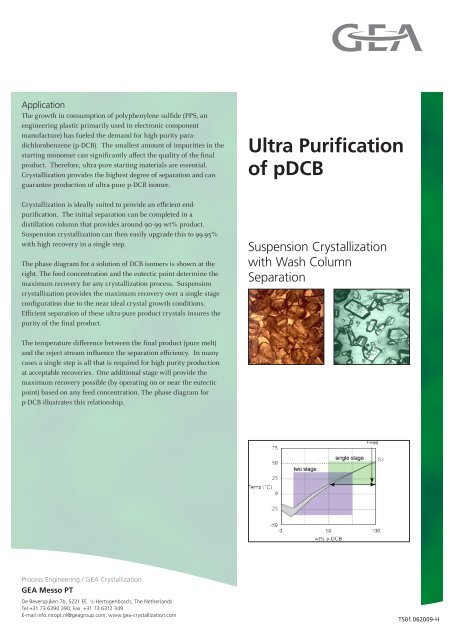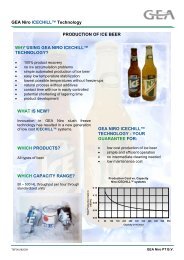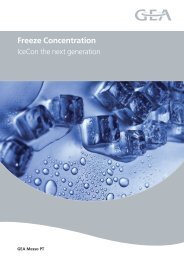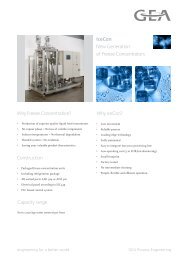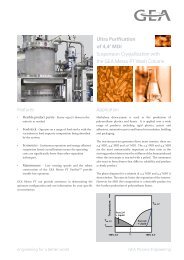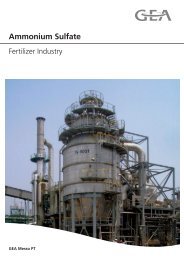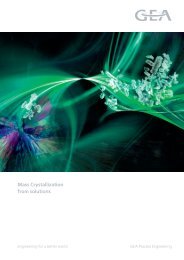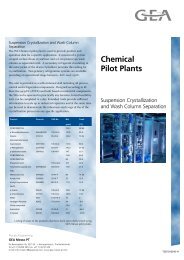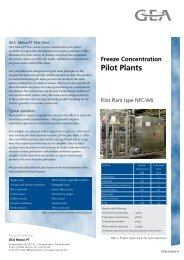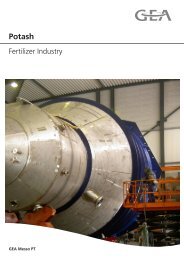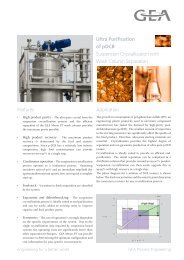Ultra Purification of pDCB - GEA Messo PT
Ultra Purification of pDCB - GEA Messo PT
Ultra Purification of pDCB - GEA Messo PT
Create successful ePaper yourself
Turn your PDF publications into a flip-book with our unique Google optimized e-Paper software.
ApplicationThe growth in consumption <strong>of</strong> polyphenylene sulfide (PPS, anengineering plastic primarily used in electronic componentmanufacture) has fueled the demand for high-purity paradichlorobenzene(p-DCB). The smallest amount <strong>of</strong> impurities in thestarting monomer can significantly affect the quality <strong>of</strong> the finalproduct. Therefore, ultra-pure starting materials are essential.Crystallization provides the highest degree <strong>of</strong> separation and canguarantee production <strong>of</strong> ultra-pure p-DCB isomer.<strong>Ultra</strong> <strong>Purification</strong><strong>of</strong> <strong>pDCB</strong>Crystallization is ideally suited to provide an efficient endpurification.The initial separation can be completed in adistillation column that provides around 90-99 wt% product.Suspension crystallization can then easily upgrade this to 99.95%with high recovery in a single step.The phase diagram for a solution <strong>of</strong> DCB isomers is shown at theright. The feed concentration and the eutectic point determine themaximum recovery for any crystallization process. Suspensioncrystallization provides the maximum recovery over a single stageconfiguration due to the near ideal crystal growth conditions.Efficient separation <strong>of</strong> these ultra-pure product crystals insures thepurity <strong>of</strong> the final product.Suspension Crystallizationwith Wash ColumnSeparationThe temperature difference between the final product (pure melt)and the reject stream influence the separation efficiency. In manycases a single step is all that is required for high purity productionat acceptable recoveries. One additional stage will provide themaximum recovery possible (by operating on or near the eutecticpoint) based on any feed concentration. The phase diagram forp-DCB illustrates this relationship.Process Engineering / <strong>GEA</strong> Crystallization<strong>GEA</strong> <strong>Messo</strong> <strong>PT</strong>De Beverspijken 7b, 5221 EE ‘s-Hertogenbosch, The NetherlandsTel +31 73 6390 390, Fax +31 73 6312 349E-mail info.niropt.nl@geagroup.com, www.gea-crystallization.comTS01.062009-H
FeaturesHigh product purity – The ultra-pure crystal from thesuspension crystallization process and the efficient separation <strong>of</strong>the <strong>GEA</strong> <strong>Messo</strong> <strong>PT</strong> wash column provides the maximum puritypossible.High product recovery – The maximum product recovery isdetermined by the feed and eutectic compositions. Since p-DCB hasa relatively low eutectic composition, high feed concentrations canprovide recoveries over 97% in a single step.Continuous operation – The suspension crystallization processoperates as a continuous process. Operating turndown ratio <strong>of</strong>50% and an immediate stop/hold (for upstream/downstreamupsets) does not require a complete start-up.Feedstock – Variations in feed impurity composition are absorbedby the system.Expansion and debottlenecking – The suspensioncrystallization process is ideally suited to end-purification and canbe easily added to existing units to improve capacity and finalproduct purity.Economics – The cost <strong>of</strong> operation is strongly dependent on thespecific requirements <strong>of</strong> the system. Due to the singlecrystallization step required by suspension based systems theoperating costs are significantly lower than other separationtechniques. <strong>GEA</strong> <strong>Messo</strong> <strong>PT</strong> can provide assistance in determiningthe optimum configuration and cost information for your specificcircumstances.Process DescriptionThe process is based on crystallization in an industry provenscraped surface vessel crystallizer and final purification completedin the <strong>GEA</strong> <strong>Messo</strong> <strong>PT</strong> purifier using this unique wash columnseparation technology. The crystallizer converts the feed into aslurry <strong>of</strong> pure product crystals and the residual mother liquor. The<strong>GEA</strong> <strong>Messo</strong> <strong>PT</strong> purifier separates this slurry into a pure productmelt and the concentrated impurities as mother liquor.Each individual crystal provides growth surface that can absorbthe supersaturation caused by cooling the product at the sweptsurface. With billions <strong>of</strong> individual crystals present, this willprovide near ideal growth conditions and insure the production <strong>of</strong>ultra-pure crystals. The resulting low growth rates possible insuspension based crystallization systems allow pure crystalproduction from even relatively impure mother liquor.The <strong>GEA</strong> <strong>Messo</strong> <strong>PT</strong> purifier completes the separation <strong>of</strong> thismixture <strong>of</strong> pure product crystals and residual mother liquor. ThePurifier is based on <strong>GEA</strong> <strong>Messo</strong> <strong>PT</strong>’s own wash column technologyand is an essential component in this purification process.A pump delivers the feed to the wash column assembly andcontrols the product output from the system. A rotating transportermechanically compresses the slurry to remove the mother liquorand form a packed crystal bed. This bed consists <strong>of</strong> the pureproduct crystals surrounded by some residual mother liquor. Thenew crystals entering the column force the bed through thecolumn toward the scraper assembly at the opposite end. Thescraper disintegrates the crystal bed and a circulation pumpprovides melted product to reslurry the crystals. The circulationflow carries the crystals to a heat exchanger where steam providesthe heat necessary to melt the crystals. The melted product leavesthrough a pressure control valve that provides the pressure neededto force the wash liquid through the packed crystal bed. Therequired pressure is adjusted depending on the level <strong>of</strong> the washfront. The wash front can be detected by the change in temperaturebetween the washed and unwashed portions <strong>of</strong> the crystal bed (seediagram).The melted product in the recirculation stream counter currentlywashes the residual mother liquor from the packed crystal bed as itmoves through the column. The wash liquid forms an internalreflux loop and therefore does not need to be recovered as withcentrifuge wash liquid. The crystal bed depth provides anextremely efficient wash zone for removal <strong>of</strong> the mother liquorinsuring complete removal <strong>of</strong> all impurities.The crystallizer consists <strong>of</strong> a jacketed vessel with a rotating scraperassembly. Refrigerant circulates in the outer jacket and cools theinner wall <strong>of</strong> the vessel.The scraper sweeps the wall surface and prevents build-up <strong>of</strong>crystals to maintain a clean heat transfer surface and continuoussupply <strong>of</strong> product crystals.Next Steps…On-site demonstration <strong>of</strong> this technology is possible in variousconfigurations from 3 kg/h up to 300 kg/h using one <strong>of</strong> <strong>GEA</strong> <strong>Messo</strong><strong>PT</strong>’s pilot plants. For more information regarding this technologyand your specific configuration requirements please contact us at:info.niropt.nl@geagroup.com or phone +31.736 390 390.


